Research Report: Effectively Supporting Multilingual Children at Home
VerifiedAdded on 2023/04/20
|56
|15472
|260
Report
AI Summary
This research report investigates effective methods for parents and practitioners to support multilingual children. It begins with an abstract highlighting the benefits of multilingualism and the study's focus on understanding the concept and consequences of multilingualism in children, including its impact on their development. The literature review covers language as a communication tool, the history of bilingualism research, and the cognitive benefits of learning multiple languages. The methodology section details the research paradigm, approach, design, data collection, and analysis methods, including ethical considerations and limitations. The results and findings section presents a thematic analysis of interview data from both parents and practitioners, revealing key insights into supporting children's bilingualism. The report concludes with recommendations for parents and practitioners, emphasizing the importance of collaboration and providing guidance for fostering language acquisition in multilingual children. Desklib provides access to this document and many other resources for students.
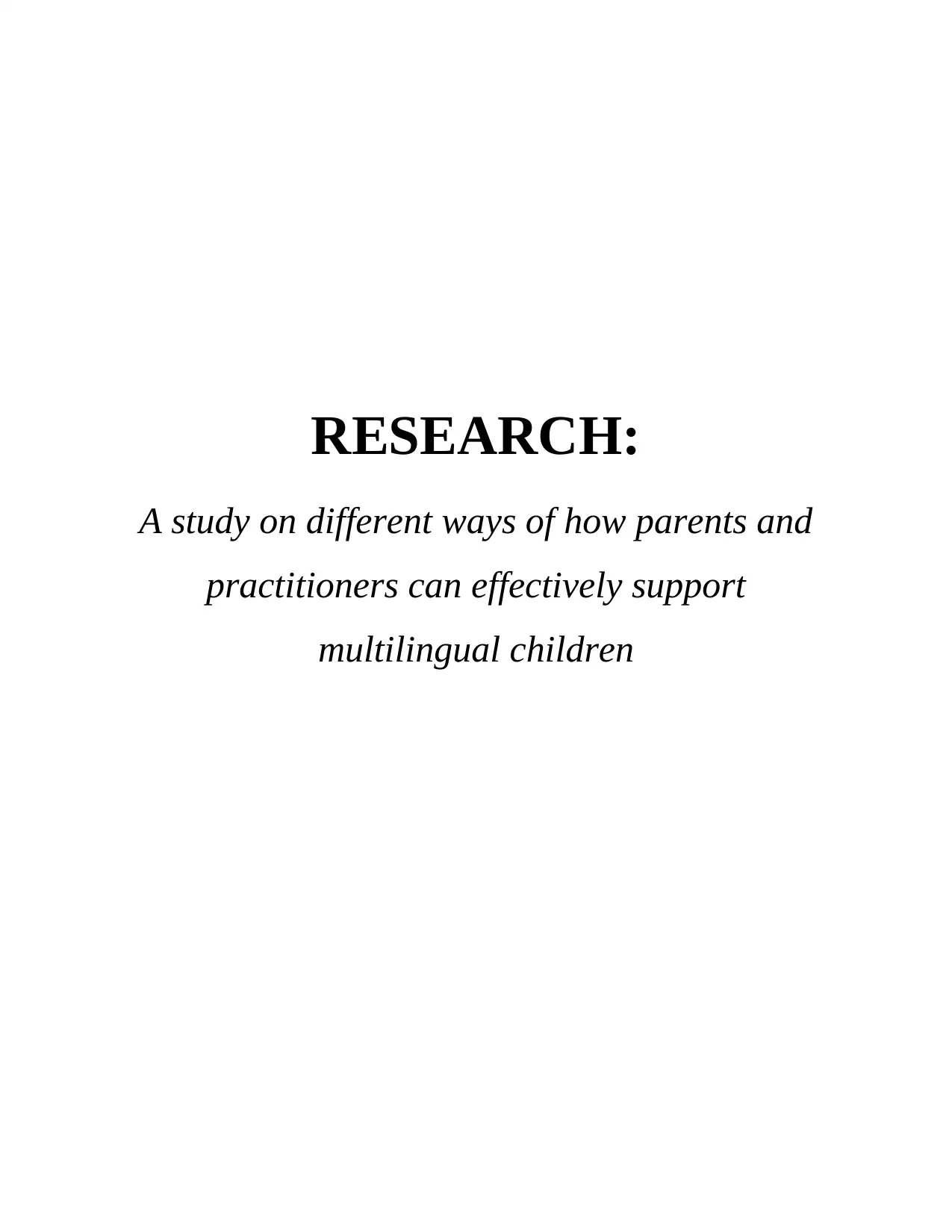
RESEARCH:
A study on different ways of how parents and
practitioners can effectively support
multilingual children
A study on different ways of how parents and
practitioners can effectively support
multilingual children
Paraphrase This Document
Need a fresh take? Get an instant paraphrase of this document with our AI Paraphraser
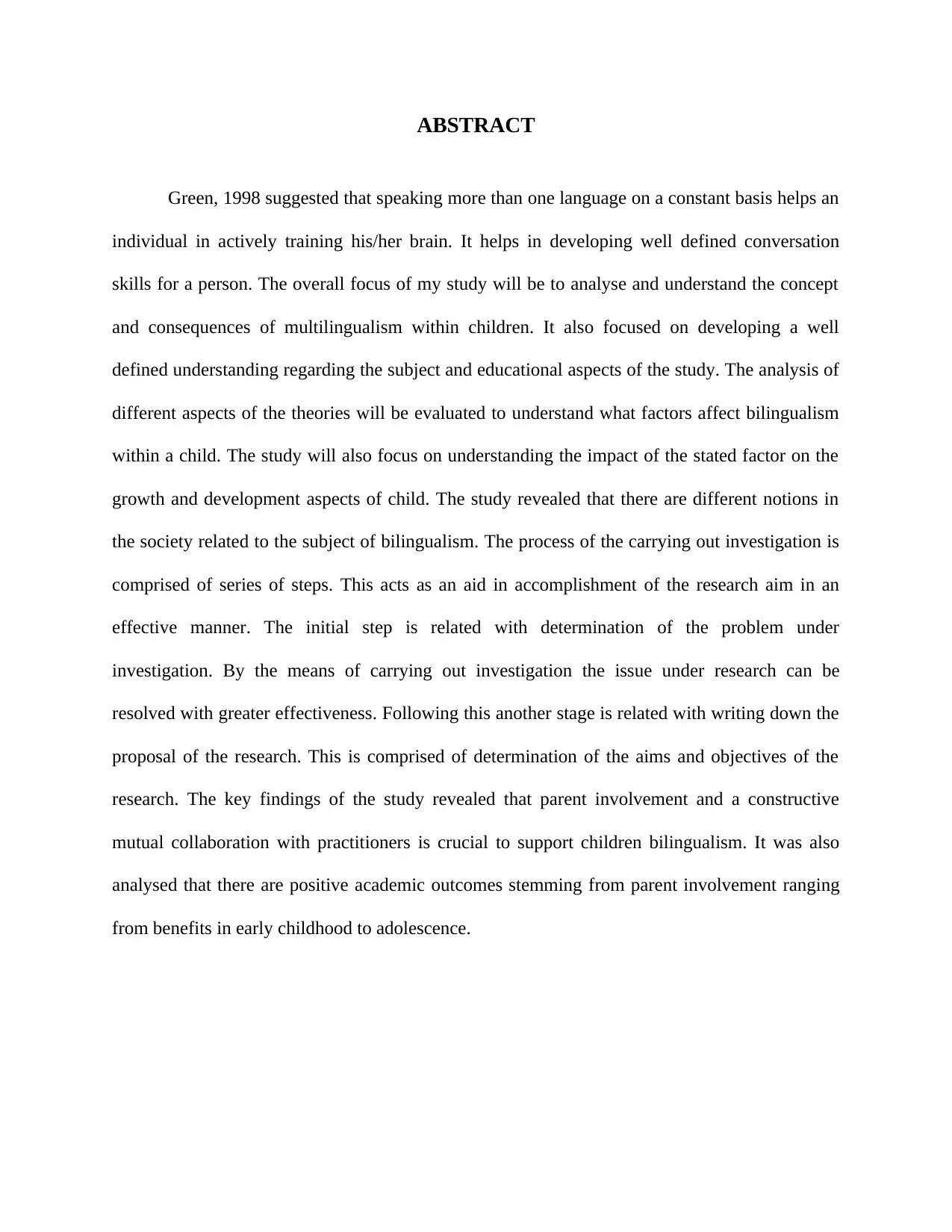
ABSTRACT
Green, 1998 suggested that speaking more than one language on a constant basis helps an
individual in actively training his/her brain. It helps in developing well defined conversation
skills for a person. The overall focus of my study will be to analyse and understand the concept
and consequences of multilingualism within children. It also focused on developing a well
defined understanding regarding the subject and educational aspects of the study. The analysis of
different aspects of the theories will be evaluated to understand what factors affect bilingualism
within a child. The study will also focus on understanding the impact of the stated factor on the
growth and development aspects of child. The study revealed that there are different notions in
the society related to the subject of bilingualism. The process of the carrying out investigation is
comprised of series of steps. This acts as an aid in accomplishment of the research aim in an
effective manner. The initial step is related with determination of the problem under
investigation. By the means of carrying out investigation the issue under research can be
resolved with greater effectiveness. Following this another stage is related with writing down the
proposal of the research. This is comprised of determination of the aims and objectives of the
research. The key findings of the study revealed that parent involvement and a constructive
mutual collaboration with practitioners is crucial to support children bilingualism. It was also
analysed that there are positive academic outcomes stemming from parent involvement ranging
from benefits in early childhood to adolescence.
Green, 1998 suggested that speaking more than one language on a constant basis helps an
individual in actively training his/her brain. It helps in developing well defined conversation
skills for a person. The overall focus of my study will be to analyse and understand the concept
and consequences of multilingualism within children. It also focused on developing a well
defined understanding regarding the subject and educational aspects of the study. The analysis of
different aspects of the theories will be evaluated to understand what factors affect bilingualism
within a child. The study will also focus on understanding the impact of the stated factor on the
growth and development aspects of child. The study revealed that there are different notions in
the society related to the subject of bilingualism. The process of the carrying out investigation is
comprised of series of steps. This acts as an aid in accomplishment of the research aim in an
effective manner. The initial step is related with determination of the problem under
investigation. By the means of carrying out investigation the issue under research can be
resolved with greater effectiveness. Following this another stage is related with writing down the
proposal of the research. This is comprised of determination of the aims and objectives of the
research. The key findings of the study revealed that parent involvement and a constructive
mutual collaboration with practitioners is crucial to support children bilingualism. It was also
analysed that there are positive academic outcomes stemming from parent involvement ranging
from benefits in early childhood to adolescence.
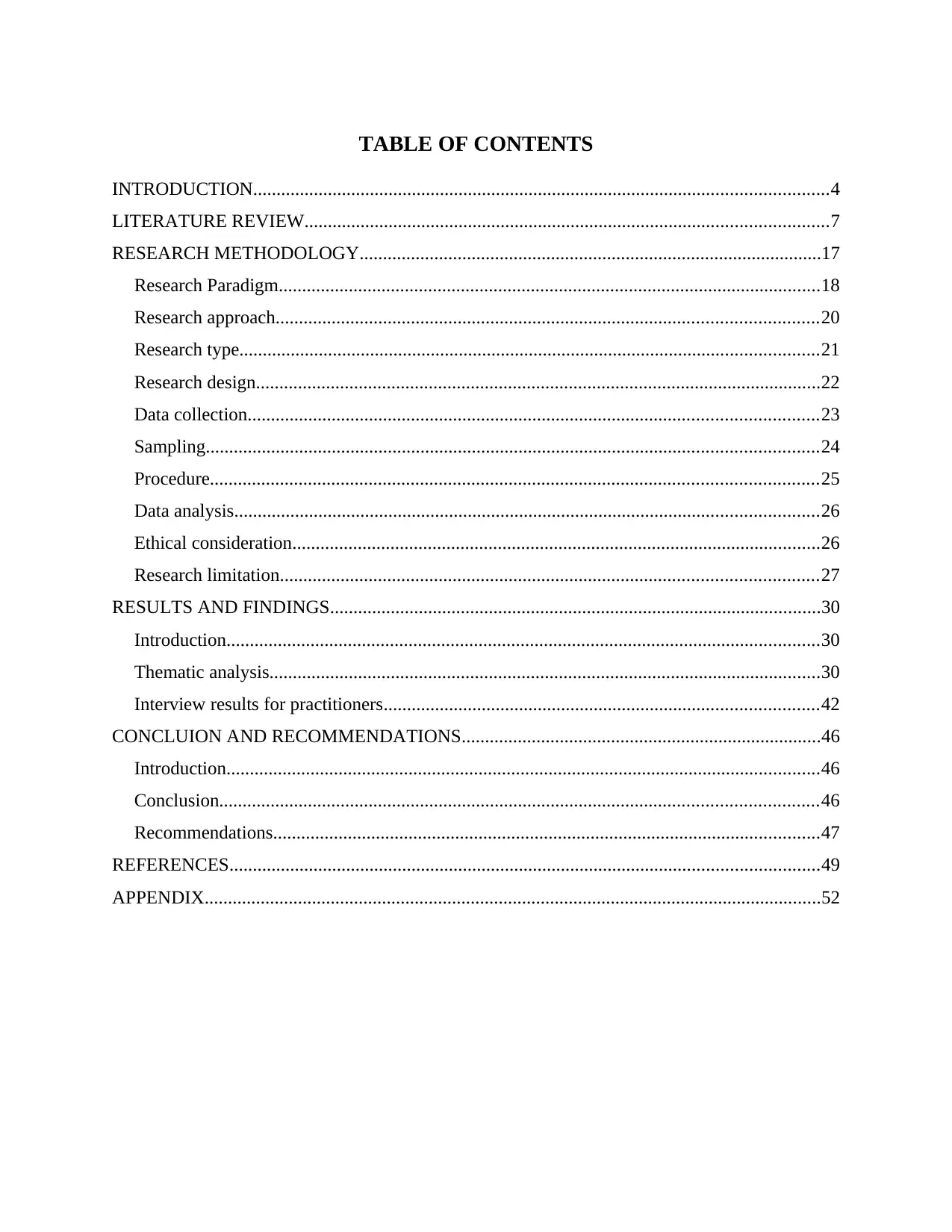
TABLE OF CONTENTS
INTRODUCTION...........................................................................................................................4
LITERATURE REVIEW................................................................................................................7
RESEARCH METHODOLOGY...................................................................................................17
Research Paradigm....................................................................................................................18
Research approach....................................................................................................................20
Research type............................................................................................................................21
Research design.........................................................................................................................22
Data collection..........................................................................................................................23
Sampling...................................................................................................................................24
Procedure..................................................................................................................................25
Data analysis.............................................................................................................................26
Ethical consideration.................................................................................................................26
Research limitation...................................................................................................................27
RESULTS AND FINDINGS.........................................................................................................30
Introduction...............................................................................................................................30
Thematic analysis......................................................................................................................30
Interview results for practitioners.............................................................................................42
CONCLUION AND RECOMMENDATIONS.............................................................................46
Introduction...............................................................................................................................46
Conclusion................................................................................................................................46
Recommendations.....................................................................................................................47
REFERENCES..............................................................................................................................49
APPENDIX....................................................................................................................................52
INTRODUCTION...........................................................................................................................4
LITERATURE REVIEW................................................................................................................7
RESEARCH METHODOLOGY...................................................................................................17
Research Paradigm....................................................................................................................18
Research approach....................................................................................................................20
Research type............................................................................................................................21
Research design.........................................................................................................................22
Data collection..........................................................................................................................23
Sampling...................................................................................................................................24
Procedure..................................................................................................................................25
Data analysis.............................................................................................................................26
Ethical consideration.................................................................................................................26
Research limitation...................................................................................................................27
RESULTS AND FINDINGS.........................................................................................................30
Introduction...............................................................................................................................30
Thematic analysis......................................................................................................................30
Interview results for practitioners.............................................................................................42
CONCLUION AND RECOMMENDATIONS.............................................................................46
Introduction...............................................................................................................................46
Conclusion................................................................................................................................46
Recommendations.....................................................................................................................47
REFERENCES..............................................................................................................................49
APPENDIX....................................................................................................................................52
⊘ This is a preview!⊘
Do you want full access?
Subscribe today to unlock all pages.

Trusted by 1+ million students worldwide
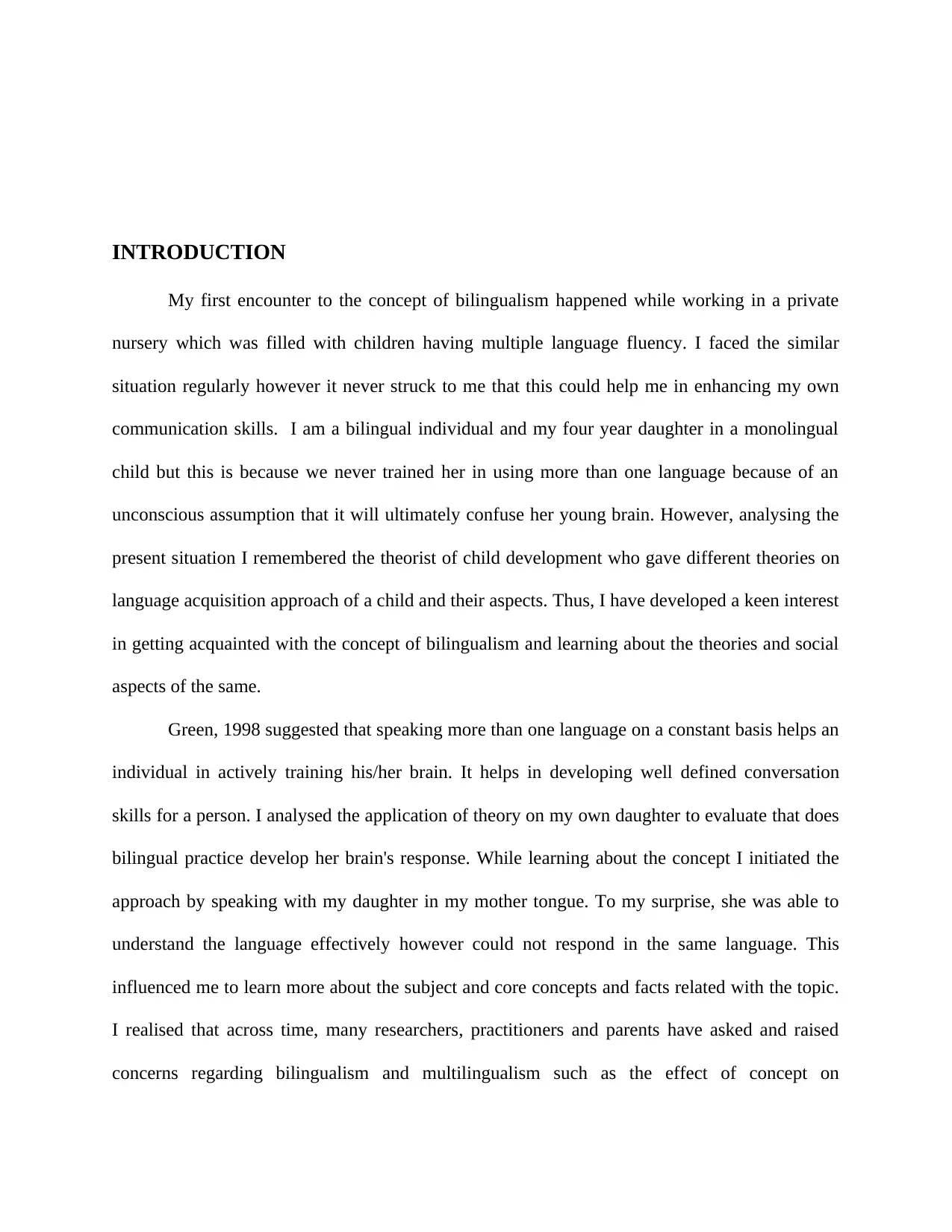
INTRODUCTION
My first encounter to the concept of bilingualism happened while working in a private
nursery which was filled with children having multiple language fluency. I faced the similar
situation regularly however it never struck to me that this could help me in enhancing my own
communication skills. I am a bilingual individual and my four year daughter in a monolingual
child but this is because we never trained her in using more than one language because of an
unconscious assumption that it will ultimately confuse her young brain. However, analysing the
present situation I remembered the theorist of child development who gave different theories on
language acquisition approach of a child and their aspects. Thus, I have developed a keen interest
in getting acquainted with the concept of bilingualism and learning about the theories and social
aspects of the same.
Green, 1998 suggested that speaking more than one language on a constant basis helps an
individual in actively training his/her brain. It helps in developing well defined conversation
skills for a person. I analysed the application of theory on my own daughter to evaluate that does
bilingual practice develop her brain's response. While learning about the concept I initiated the
approach by speaking with my daughter in my mother tongue. To my surprise, she was able to
understand the language effectively however could not respond in the same language. This
influenced me to learn more about the subject and core concepts and facts related with the topic.
I realised that across time, many researchers, practitioners and parents have asked and raised
concerns regarding bilingualism and multilingualism such as the effect of concept on
My first encounter to the concept of bilingualism happened while working in a private
nursery which was filled with children having multiple language fluency. I faced the similar
situation regularly however it never struck to me that this could help me in enhancing my own
communication skills. I am a bilingual individual and my four year daughter in a monolingual
child but this is because we never trained her in using more than one language because of an
unconscious assumption that it will ultimately confuse her young brain. However, analysing the
present situation I remembered the theorist of child development who gave different theories on
language acquisition approach of a child and their aspects. Thus, I have developed a keen interest
in getting acquainted with the concept of bilingualism and learning about the theories and social
aspects of the same.
Green, 1998 suggested that speaking more than one language on a constant basis helps an
individual in actively training his/her brain. It helps in developing well defined conversation
skills for a person. I analysed the application of theory on my own daughter to evaluate that does
bilingual practice develop her brain's response. While learning about the concept I initiated the
approach by speaking with my daughter in my mother tongue. To my surprise, she was able to
understand the language effectively however could not respond in the same language. This
influenced me to learn more about the subject and core concepts and facts related with the topic.
I realised that across time, many researchers, practitioners and parents have asked and raised
concerns regarding bilingualism and multilingualism such as the effect of concept on
Paraphrase This Document
Need a fresh take? Get an instant paraphrase of this document with our AI Paraphraser
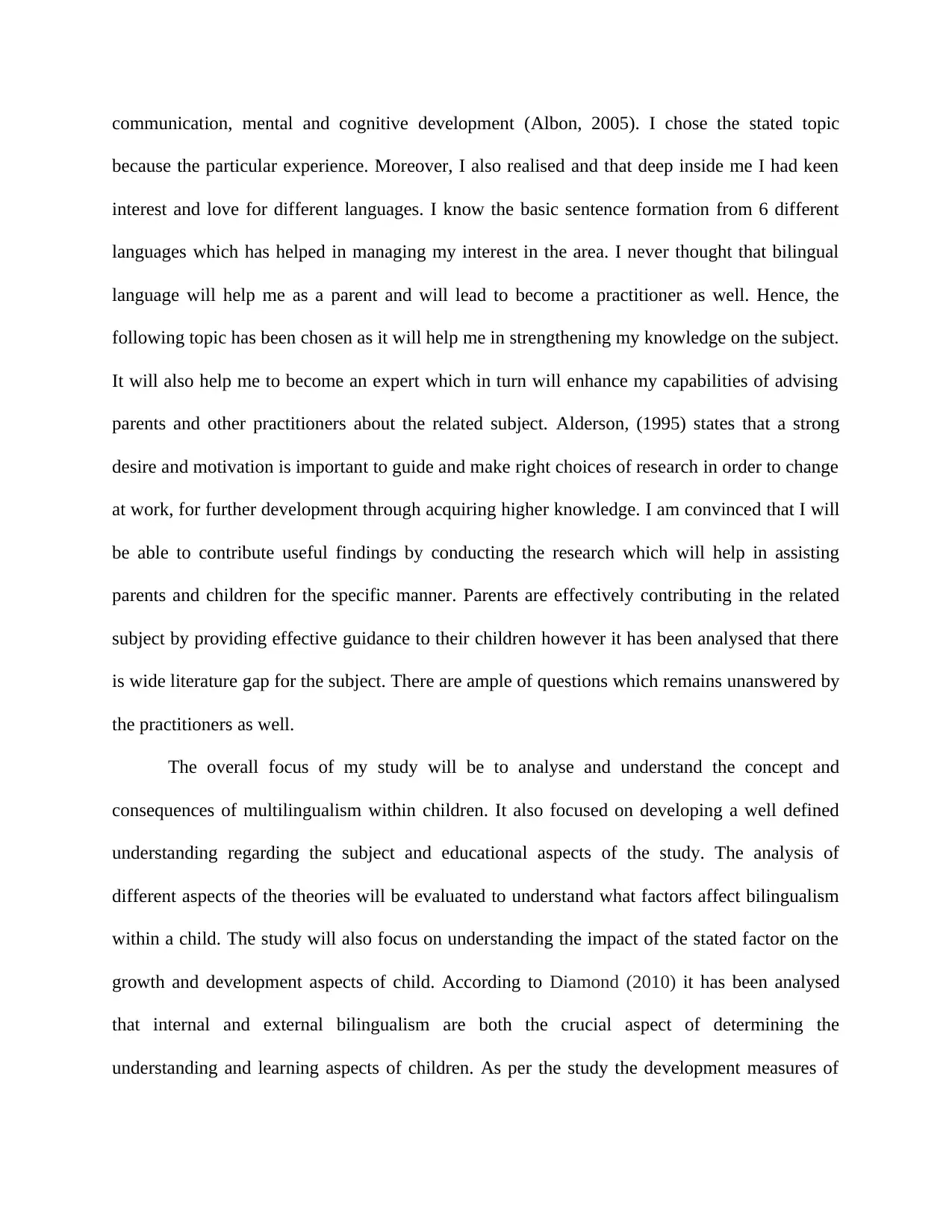
communication, mental and cognitive development (Albon, 2005). I chose the stated topic
because the particular experience. Moreover, I also realised and that deep inside me I had keen
interest and love for different languages. I know the basic sentence formation from 6 different
languages which has helped in managing my interest in the area. I never thought that bilingual
language will help me as a parent and will lead to become a practitioner as well. Hence, the
following topic has been chosen as it will help me in strengthening my knowledge on the subject.
It will also help me to become an expert which in turn will enhance my capabilities of advising
parents and other practitioners about the related subject. Alderson, (1995) states that a strong
desire and motivation is important to guide and make right choices of research in order to change
at work, for further development through acquiring higher knowledge. I am convinced that I will
be able to contribute useful findings by conducting the research which will help in assisting
parents and children for the specific manner. Parents are effectively contributing in the related
subject by providing effective guidance to their children however it has been analysed that there
is wide literature gap for the subject. There are ample of questions which remains unanswered by
the practitioners as well.
The overall focus of my study will be to analyse and understand the concept and
consequences of multilingualism within children. It also focused on developing a well defined
understanding regarding the subject and educational aspects of the study. The analysis of
different aspects of the theories will be evaluated to understand what factors affect bilingualism
within a child. The study will also focus on understanding the impact of the stated factor on the
growth and development aspects of child. According to Diamond (2010) it has been analysed
that internal and external bilingualism are both the crucial aspect of determining the
understanding and learning aspects of children. As per the study the development measures of
because the particular experience. Moreover, I also realised and that deep inside me I had keen
interest and love for different languages. I know the basic sentence formation from 6 different
languages which has helped in managing my interest in the area. I never thought that bilingual
language will help me as a parent and will lead to become a practitioner as well. Hence, the
following topic has been chosen as it will help me in strengthening my knowledge on the subject.
It will also help me to become an expert which in turn will enhance my capabilities of advising
parents and other practitioners about the related subject. Alderson, (1995) states that a strong
desire and motivation is important to guide and make right choices of research in order to change
at work, for further development through acquiring higher knowledge. I am convinced that I will
be able to contribute useful findings by conducting the research which will help in assisting
parents and children for the specific manner. Parents are effectively contributing in the related
subject by providing effective guidance to their children however it has been analysed that there
is wide literature gap for the subject. There are ample of questions which remains unanswered by
the practitioners as well.
The overall focus of my study will be to analyse and understand the concept and
consequences of multilingualism within children. It also focused on developing a well defined
understanding regarding the subject and educational aspects of the study. The analysis of
different aspects of the theories will be evaluated to understand what factors affect bilingualism
within a child. The study will also focus on understanding the impact of the stated factor on the
growth and development aspects of child. According to Diamond (2010) it has been analysed
that internal and external bilingualism are both the crucial aspect of determining the
understanding and learning aspects of children. As per the study the development measures of
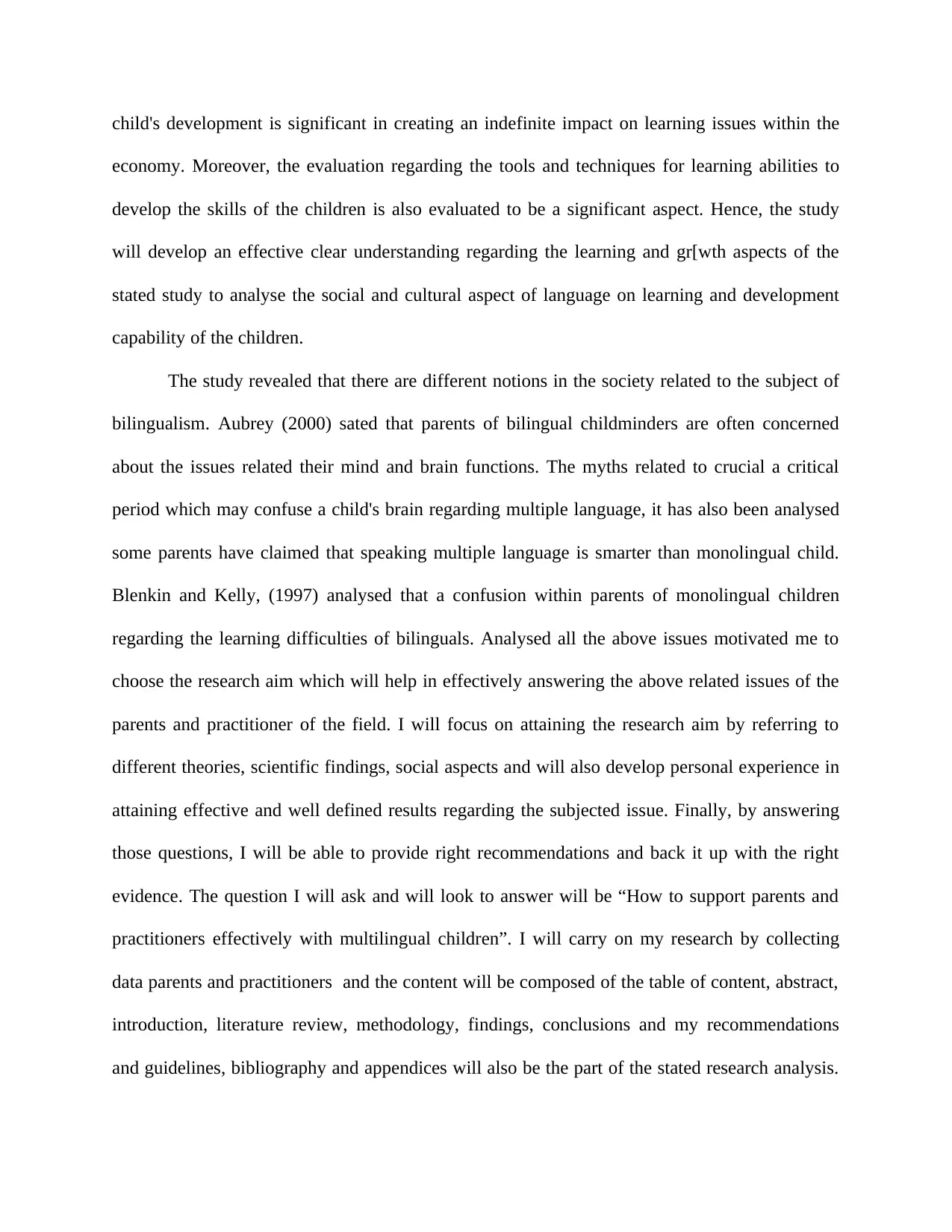
child's development is significant in creating an indefinite impact on learning issues within the
economy. Moreover, the evaluation regarding the tools and techniques for learning abilities to
develop the skills of the children is also evaluated to be a significant aspect. Hence, the study
will develop an effective clear understanding regarding the learning and gr[wth aspects of the
stated study to analyse the social and cultural aspect of language on learning and development
capability of the children.
The study revealed that there are different notions in the society related to the subject of
bilingualism. Aubrey (2000) sated that parents of bilingual childminders are often concerned
about the issues related their mind and brain functions. The myths related to crucial a critical
period which may confuse a child's brain regarding multiple language, it has also been analysed
some parents have claimed that speaking multiple language is smarter than monolingual child.
Blenkin and Kelly, (1997) analysed that a confusion within parents of monolingual children
regarding the learning difficulties of bilinguals. Analysed all the above issues motivated me to
choose the research aim which will help in effectively answering the above related issues of the
parents and practitioner of the field. I will focus on attaining the research aim by referring to
different theories, scientific findings, social aspects and will also develop personal experience in
attaining effective and well defined results regarding the subjected issue. Finally, by answering
those questions, I will be able to provide right recommendations and back it up with the right
evidence. The question I will ask and will look to answer will be “How to support parents and
practitioners effectively with multilingual children”. I will carry on my research by collecting
data parents and practitioners and the content will be composed of the table of content, abstract,
introduction, literature review, methodology, findings, conclusions and my recommendations
and guidelines, bibliography and appendices will also be the part of the stated research analysis.
economy. Moreover, the evaluation regarding the tools and techniques for learning abilities to
develop the skills of the children is also evaluated to be a significant aspect. Hence, the study
will develop an effective clear understanding regarding the learning and gr[wth aspects of the
stated study to analyse the social and cultural aspect of language on learning and development
capability of the children.
The study revealed that there are different notions in the society related to the subject of
bilingualism. Aubrey (2000) sated that parents of bilingual childminders are often concerned
about the issues related their mind and brain functions. The myths related to crucial a critical
period which may confuse a child's brain regarding multiple language, it has also been analysed
some parents have claimed that speaking multiple language is smarter than monolingual child.
Blenkin and Kelly, (1997) analysed that a confusion within parents of monolingual children
regarding the learning difficulties of bilinguals. Analysed all the above issues motivated me to
choose the research aim which will help in effectively answering the above related issues of the
parents and practitioner of the field. I will focus on attaining the research aim by referring to
different theories, scientific findings, social aspects and will also develop personal experience in
attaining effective and well defined results regarding the subjected issue. Finally, by answering
those questions, I will be able to provide right recommendations and back it up with the right
evidence. The question I will ask and will look to answer will be “How to support parents and
practitioners effectively with multilingual children”. I will carry on my research by collecting
data parents and practitioners and the content will be composed of the table of content, abstract,
introduction, literature review, methodology, findings, conclusions and my recommendations
and guidelines, bibliography and appendices will also be the part of the stated research analysis.
⊘ This is a preview!⊘
Do you want full access?
Subscribe today to unlock all pages.

Trusted by 1+ million students worldwide
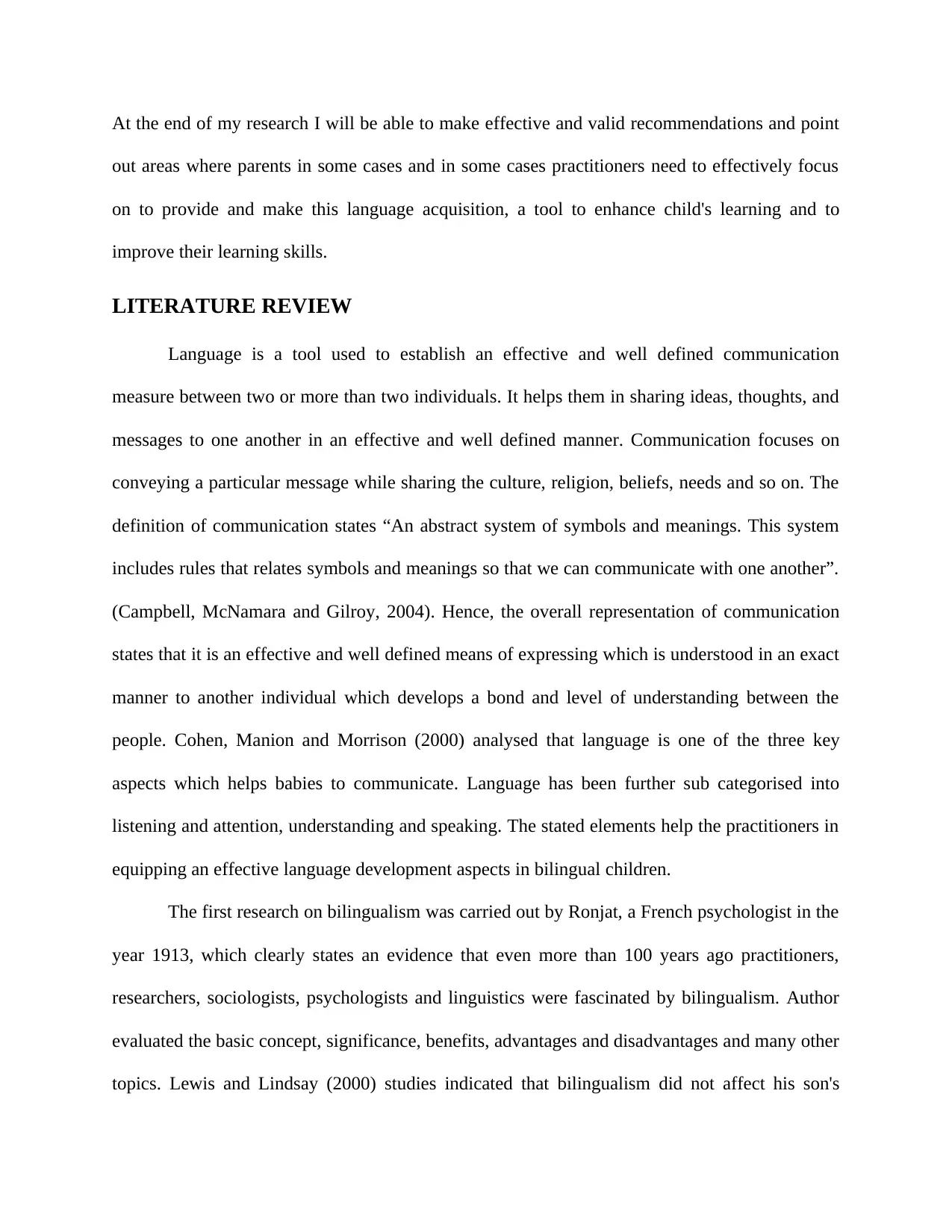
At the end of my research I will be able to make effective and valid recommendations and point
out areas where parents in some cases and in some cases practitioners need to effectively focus
on to provide and make this language acquisition, a tool to enhance child's learning and to
improve their learning skills.
LITERATURE REVIEW
Language is a tool used to establish an effective and well defined communication
measure between two or more than two individuals. It helps them in sharing ideas, thoughts, and
messages to one another in an effective and well defined manner. Communication focuses on
conveying a particular message while sharing the culture, religion, beliefs, needs and so on. The
definition of communication states “An abstract system of symbols and meanings. This system
includes rules that relates symbols and meanings so that we can communicate with one another”.
(Campbell, McNamara and Gilroy, 2004). Hence, the overall representation of communication
states that it is an effective and well defined means of expressing which is understood in an exact
manner to another individual which develops a bond and level of understanding between the
people. Cohen, Manion and Morrison (2000) analysed that language is one of the three key
aspects which helps babies to communicate. Language has been further sub categorised into
listening and attention, understanding and speaking. The stated elements help the practitioners in
equipping an effective language development aspects in bilingual children.
The first research on bilingualism was carried out by Ronjat, a French psychologist in the
year 1913, which clearly states an evidence that even more than 100 years ago practitioners,
researchers, sociologists, psychologists and linguistics were fascinated by bilingualism. Author
evaluated the basic concept, significance, benefits, advantages and disadvantages and many other
topics. Lewis and Lindsay (2000) studies indicated that bilingualism did not affect his son's
out areas where parents in some cases and in some cases practitioners need to effectively focus
on to provide and make this language acquisition, a tool to enhance child's learning and to
improve their learning skills.
LITERATURE REVIEW
Language is a tool used to establish an effective and well defined communication
measure between two or more than two individuals. It helps them in sharing ideas, thoughts, and
messages to one another in an effective and well defined manner. Communication focuses on
conveying a particular message while sharing the culture, religion, beliefs, needs and so on. The
definition of communication states “An abstract system of symbols and meanings. This system
includes rules that relates symbols and meanings so that we can communicate with one another”.
(Campbell, McNamara and Gilroy, 2004). Hence, the overall representation of communication
states that it is an effective and well defined means of expressing which is understood in an exact
manner to another individual which develops a bond and level of understanding between the
people. Cohen, Manion and Morrison (2000) analysed that language is one of the three key
aspects which helps babies to communicate. Language has been further sub categorised into
listening and attention, understanding and speaking. The stated elements help the practitioners in
equipping an effective language development aspects in bilingual children.
The first research on bilingualism was carried out by Ronjat, a French psychologist in the
year 1913, which clearly states an evidence that even more than 100 years ago practitioners,
researchers, sociologists, psychologists and linguistics were fascinated by bilingualism. Author
evaluated the basic concept, significance, benefits, advantages and disadvantages and many other
topics. Lewis and Lindsay (2000) studies indicated that bilingualism did not affect his son's
Paraphrase This Document
Need a fresh take? Get an instant paraphrase of this document with our AI Paraphraser
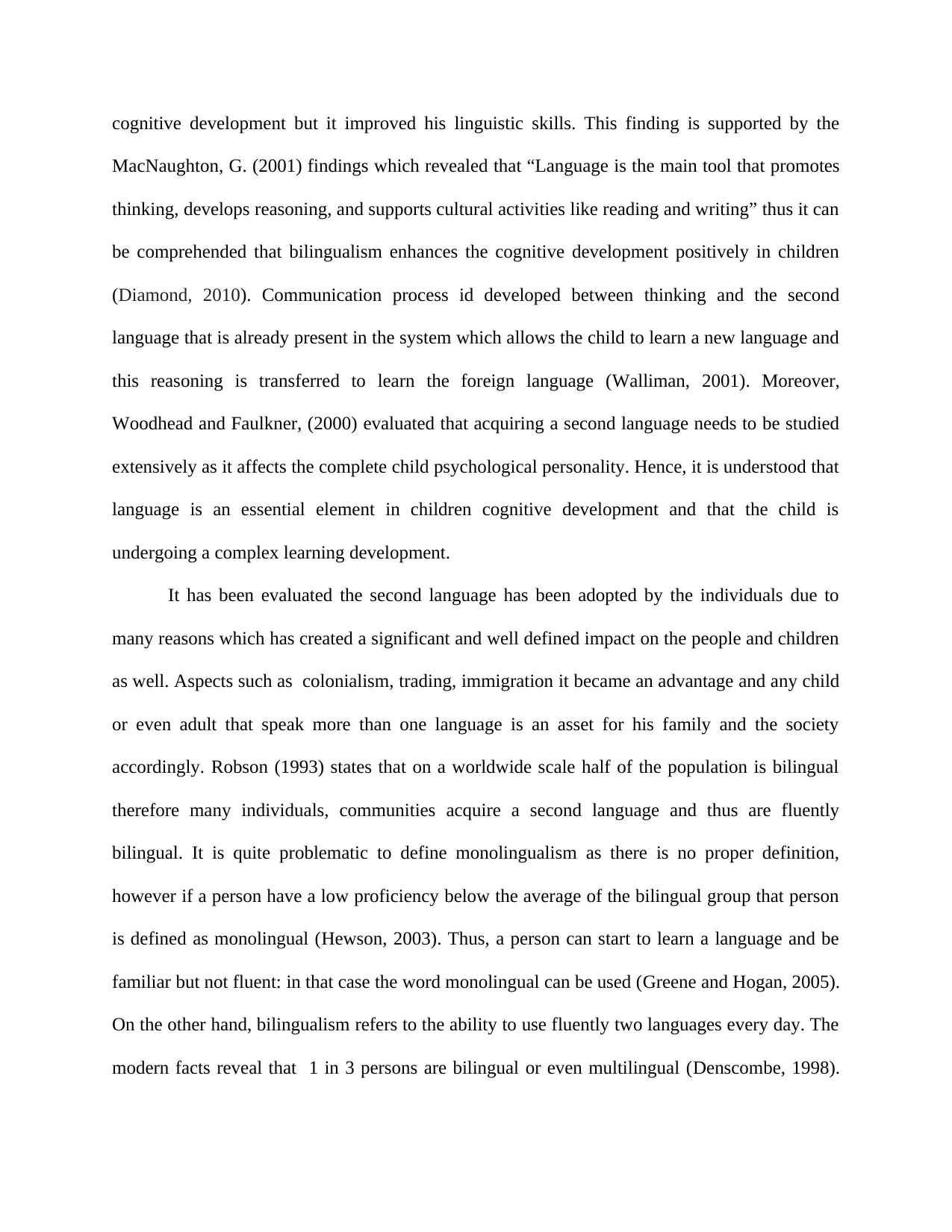
cognitive development but it improved his linguistic skills. This finding is supported by the
MacNaughton, G. (2001) findings which revealed that “Language is the main tool that promotes
thinking, develops reasoning, and supports cultural activities like reading and writing” thus it can
be comprehended that bilingualism enhances the cognitive development positively in children
(Diamond, 2010). Communication process id developed between thinking and the second
language that is already present in the system which allows the child to learn a new language and
this reasoning is transferred to learn the foreign language (Walliman, 2001). Moreover,
Woodhead and Faulkner, (2000) evaluated that acquiring a second language needs to be studied
extensively as it affects the complete child psychological personality. Hence, it is understood that
language is an essential element in children cognitive development and that the child is
undergoing a complex learning development.
It has been evaluated the second language has been adopted by the individuals due to
many reasons which has created a significant and well defined impact on the people and children
as well. Aspects such as colonialism, trading, immigration it became an advantage and any child
or even adult that speak more than one language is an asset for his family and the society
accordingly. Robson (1993) states that on a worldwide scale half of the population is bilingual
therefore many individuals, communities acquire a second language and thus are fluently
bilingual. It is quite problematic to define monolingualism as there is no proper definition,
however if a person have a low proficiency below the average of the bilingual group that person
is defined as monolingual (Hewson, 2003). Thus, a person can start to learn a language and be
familiar but not fluent: in that case the word monolingual can be used (Greene and Hogan, 2005).
On the other hand, bilingualism refers to the ability to use fluently two languages every day. The
modern facts reveal that 1 in 3 persons are bilingual or even multilingual (Denscombe, 1998).
MacNaughton, G. (2001) findings which revealed that “Language is the main tool that promotes
thinking, develops reasoning, and supports cultural activities like reading and writing” thus it can
be comprehended that bilingualism enhances the cognitive development positively in children
(Diamond, 2010). Communication process id developed between thinking and the second
language that is already present in the system which allows the child to learn a new language and
this reasoning is transferred to learn the foreign language (Walliman, 2001). Moreover,
Woodhead and Faulkner, (2000) evaluated that acquiring a second language needs to be studied
extensively as it affects the complete child psychological personality. Hence, it is understood that
language is an essential element in children cognitive development and that the child is
undergoing a complex learning development.
It has been evaluated the second language has been adopted by the individuals due to
many reasons which has created a significant and well defined impact on the people and children
as well. Aspects such as colonialism, trading, immigration it became an advantage and any child
or even adult that speak more than one language is an asset for his family and the society
accordingly. Robson (1993) states that on a worldwide scale half of the population is bilingual
therefore many individuals, communities acquire a second language and thus are fluently
bilingual. It is quite problematic to define monolingualism as there is no proper definition,
however if a person have a low proficiency below the average of the bilingual group that person
is defined as monolingual (Hewson, 2003). Thus, a person can start to learn a language and be
familiar but not fluent: in that case the word monolingual can be used (Greene and Hogan, 2005).
On the other hand, bilingualism refers to the ability to use fluently two languages every day. The
modern facts reveal that 1 in 3 persons are bilingual or even multilingual (Denscombe, 1998).
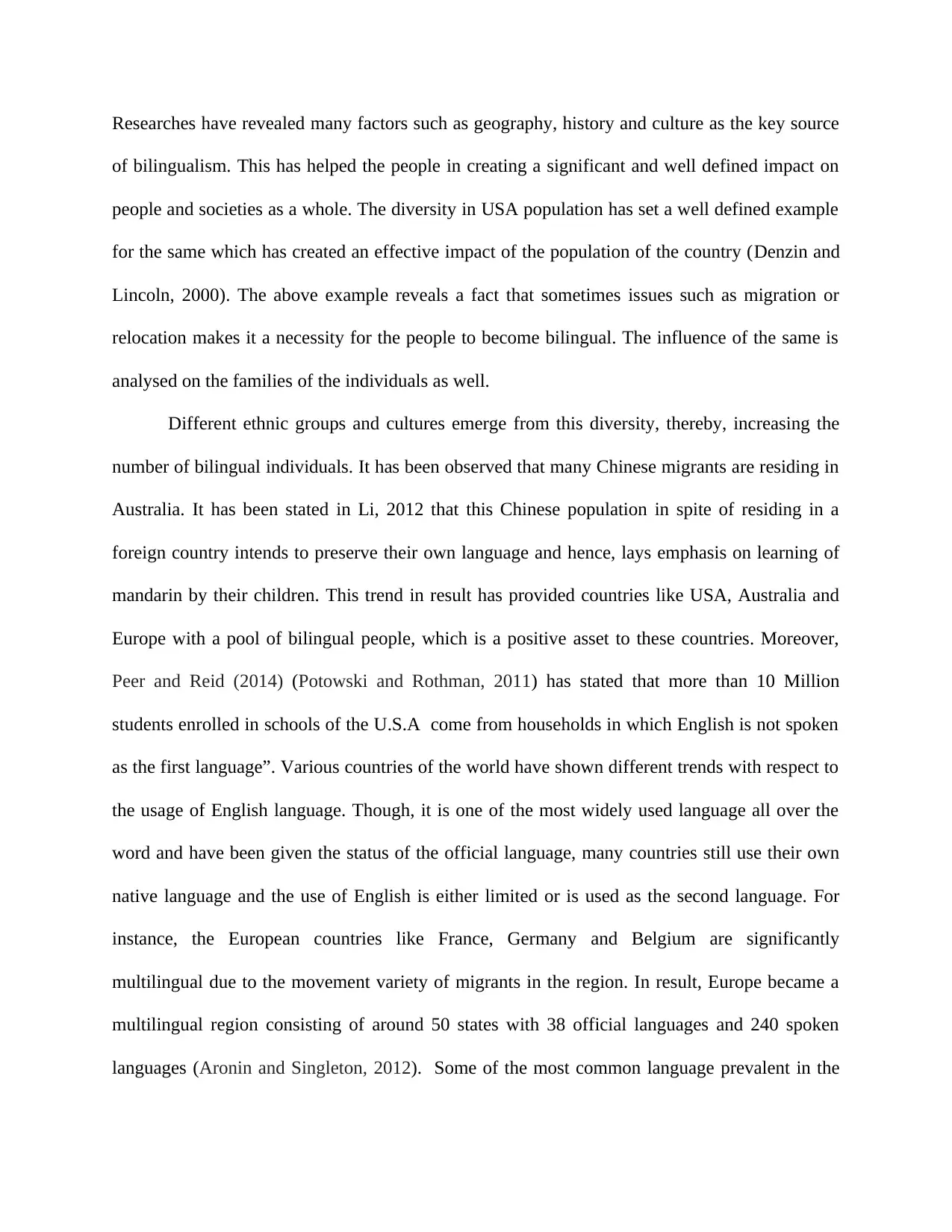
Researches have revealed many factors such as geography, history and culture as the key source
of bilingualism. This has helped the people in creating a significant and well defined impact on
people and societies as a whole. The diversity in USA population has set a well defined example
for the same which has created an effective impact of the population of the country (Denzin and
Lincoln, 2000). The above example reveals a fact that sometimes issues such as migration or
relocation makes it a necessity for the people to become bilingual. The influence of the same is
analysed on the families of the individuals as well.
Different ethnic groups and cultures emerge from this diversity, thereby, increasing the
number of bilingual individuals. It has been observed that many Chinese migrants are residing in
Australia. It has been stated in Li, 2012 that this Chinese population in spite of residing in a
foreign country intends to preserve their own language and hence, lays emphasis on learning of
mandarin by their children. This trend in result has provided countries like USA, Australia and
Europe with a pool of bilingual people, which is a positive asset to these countries. Moreover,
Peer and Reid (2014) (Potowski and Rothman, 2011) has stated that more than 10 Million
students enrolled in schools of the U.S.A come from households in which English is not spoken
as the first language”. Various countries of the world have shown different trends with respect to
the usage of English language. Though, it is one of the most widely used language all over the
word and have been given the status of the official language, many countries still use their own
native language and the use of English is either limited or is used as the second language. For
instance, the European countries like France, Germany and Belgium are significantly
multilingual due to the movement variety of migrants in the region. In result, Europe became a
multilingual region consisting of around 50 states with 38 official languages and 240 spoken
languages (Aronin and Singleton, 2012). Some of the most common language prevalent in the
of bilingualism. This has helped the people in creating a significant and well defined impact on
people and societies as a whole. The diversity in USA population has set a well defined example
for the same which has created an effective impact of the population of the country (Denzin and
Lincoln, 2000). The above example reveals a fact that sometimes issues such as migration or
relocation makes it a necessity for the people to become bilingual. The influence of the same is
analysed on the families of the individuals as well.
Different ethnic groups and cultures emerge from this diversity, thereby, increasing the
number of bilingual individuals. It has been observed that many Chinese migrants are residing in
Australia. It has been stated in Li, 2012 that this Chinese population in spite of residing in a
foreign country intends to preserve their own language and hence, lays emphasis on learning of
mandarin by their children. This trend in result has provided countries like USA, Australia and
Europe with a pool of bilingual people, which is a positive asset to these countries. Moreover,
Peer and Reid (2014) (Potowski and Rothman, 2011) has stated that more than 10 Million
students enrolled in schools of the U.S.A come from households in which English is not spoken
as the first language”. Various countries of the world have shown different trends with respect to
the usage of English language. Though, it is one of the most widely used language all over the
word and have been given the status of the official language, many countries still use their own
native language and the use of English is either limited or is used as the second language. For
instance, the European countries like France, Germany and Belgium are significantly
multilingual due to the movement variety of migrants in the region. In result, Europe became a
multilingual region consisting of around 50 states with 38 official languages and 240 spoken
languages (Aronin and Singleton, 2012). Some of the most common language prevalent in the
⊘ This is a preview!⊘
Do you want full access?
Subscribe today to unlock all pages.

Trusted by 1+ million students worldwide
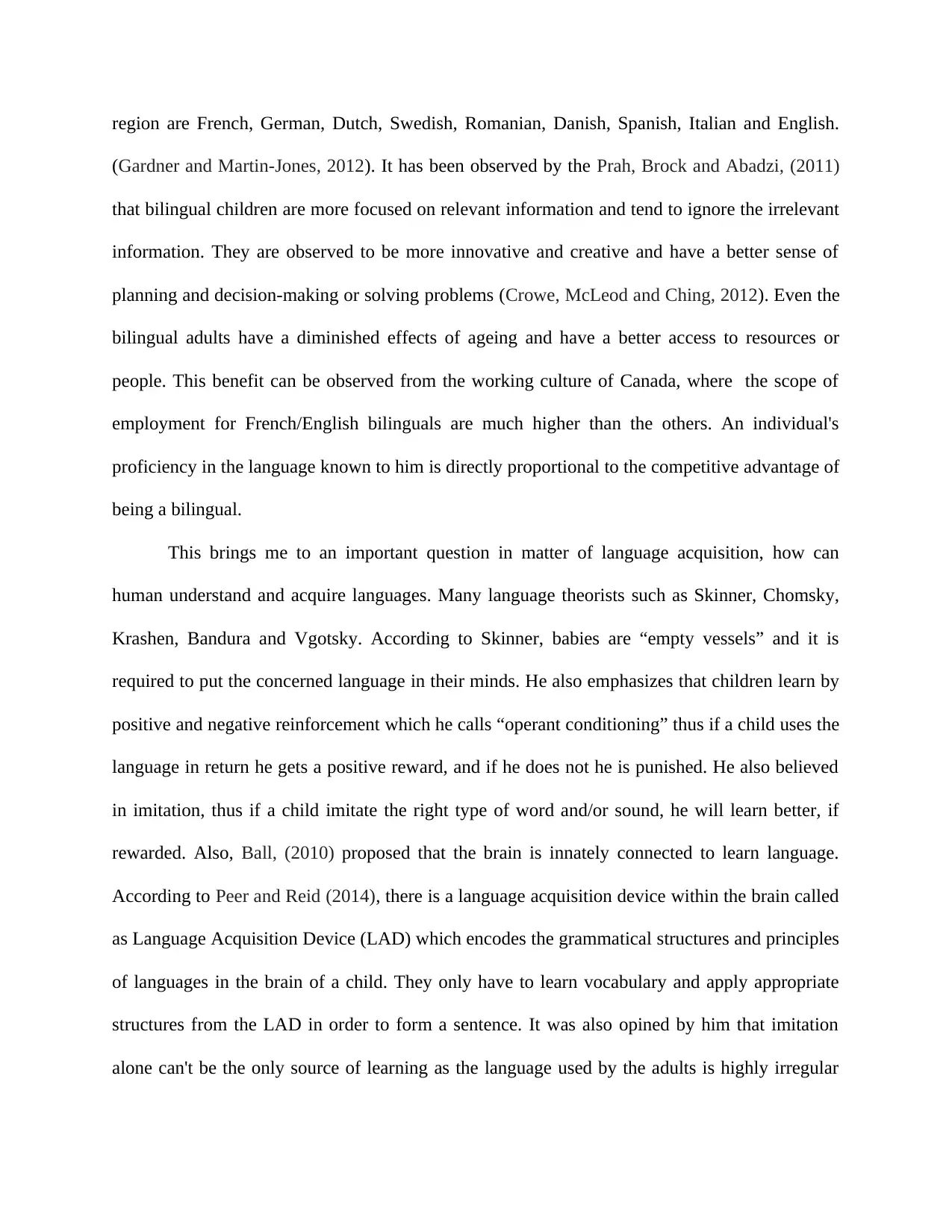
region are French, German, Dutch, Swedish, Romanian, Danish, Spanish, Italian and English.
(Gardner and Martin-Jones, 2012). It has been observed by the Prah, Brock and Abadzi, (2011)
that bilingual children are more focused on relevant information and tend to ignore the irrelevant
information. They are observed to be more innovative and creative and have a better sense of
planning and decision-making or solving problems (Crowe, McLeod and Ching, 2012). Even the
bilingual adults have a diminished effects of ageing and have a better access to resources or
people. This benefit can be observed from the working culture of Canada, where the scope of
employment for French/English bilinguals are much higher than the others. An individual's
proficiency in the language known to him is directly proportional to the competitive advantage of
being a bilingual.
This brings me to an important question in matter of language acquisition, how can
human understand and acquire languages. Many language theorists such as Skinner, Chomsky,
Krashen, Bandura and Vgotsky. According to Skinner, babies are “empty vessels” and it is
required to put the concerned language in their minds. He also emphasizes that children learn by
positive and negative reinforcement which he calls “operant conditioning” thus if a child uses the
language in return he gets a positive reward, and if he does not he is punished. He also believed
in imitation, thus if a child imitate the right type of word and/or sound, he will learn better, if
rewarded. Also, Ball, (2010) proposed that the brain is innately connected to learn language.
According to Peer and Reid (2014), there is a language acquisition device within the brain called
as Language Acquisition Device (LAD) which encodes the grammatical structures and principles
of languages in the brain of a child. They only have to learn vocabulary and apply appropriate
structures from the LAD in order to form a sentence. It was also opined by him that imitation
alone can't be the only source of learning as the language used by the adults is highly irregular
(Gardner and Martin-Jones, 2012). It has been observed by the Prah, Brock and Abadzi, (2011)
that bilingual children are more focused on relevant information and tend to ignore the irrelevant
information. They are observed to be more innovative and creative and have a better sense of
planning and decision-making or solving problems (Crowe, McLeod and Ching, 2012). Even the
bilingual adults have a diminished effects of ageing and have a better access to resources or
people. This benefit can be observed from the working culture of Canada, where the scope of
employment for French/English bilinguals are much higher than the others. An individual's
proficiency in the language known to him is directly proportional to the competitive advantage of
being a bilingual.
This brings me to an important question in matter of language acquisition, how can
human understand and acquire languages. Many language theorists such as Skinner, Chomsky,
Krashen, Bandura and Vgotsky. According to Skinner, babies are “empty vessels” and it is
required to put the concerned language in their minds. He also emphasizes that children learn by
positive and negative reinforcement which he calls “operant conditioning” thus if a child uses the
language in return he gets a positive reward, and if he does not he is punished. He also believed
in imitation, thus if a child imitate the right type of word and/or sound, he will learn better, if
rewarded. Also, Ball, (2010) proposed that the brain is innately connected to learn language.
According to Peer and Reid (2014), there is a language acquisition device within the brain called
as Language Acquisition Device (LAD) which encodes the grammatical structures and principles
of languages in the brain of a child. They only have to learn vocabulary and apply appropriate
structures from the LAD in order to form a sentence. It was also opined by him that imitation
alone can't be the only source of learning as the language used by the adults is highly irregular
Paraphrase This Document
Need a fresh take? Get an instant paraphrase of this document with our AI Paraphraser
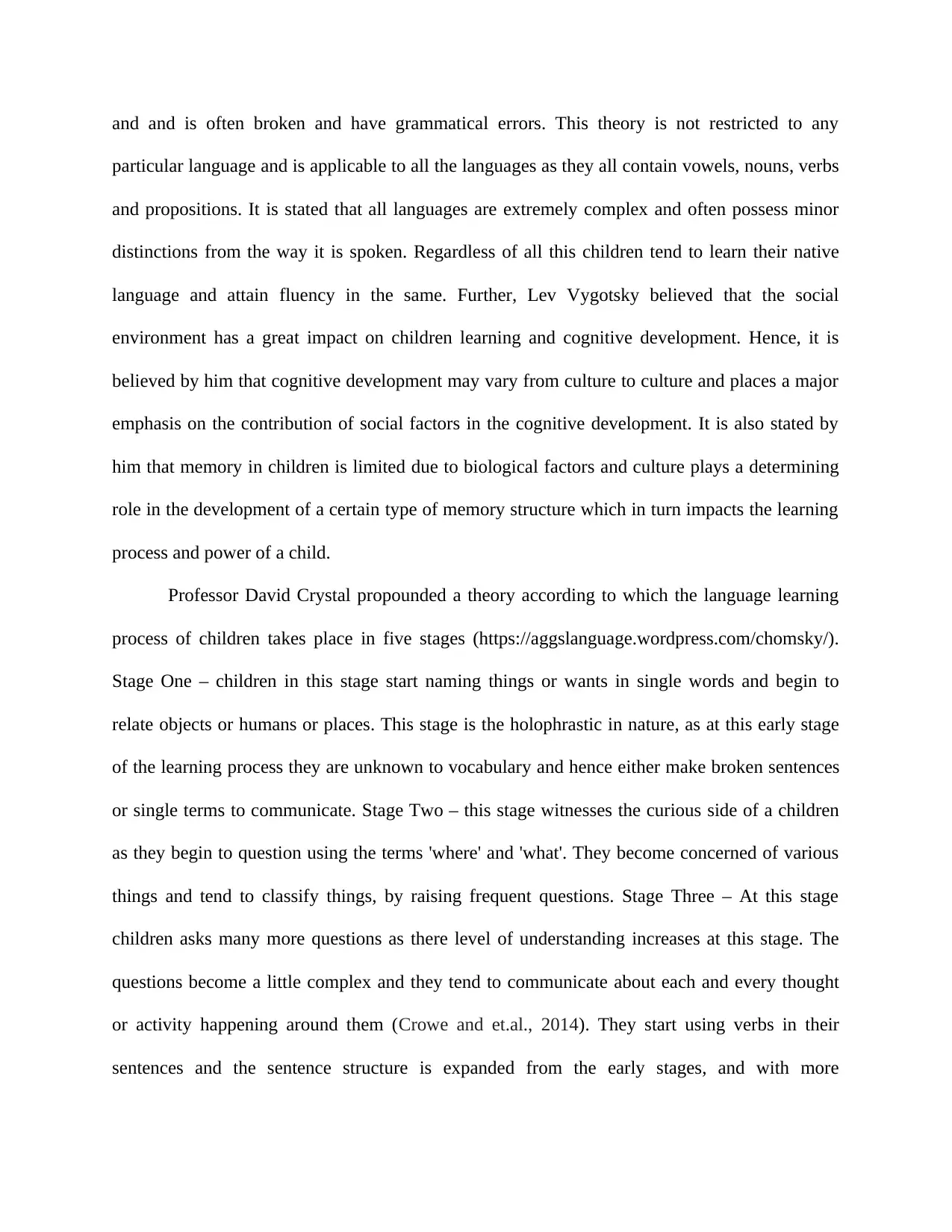
and and is often broken and have grammatical errors. This theory is not restricted to any
particular language and is applicable to all the languages as they all contain vowels, nouns, verbs
and propositions. It is stated that all languages are extremely complex and often possess minor
distinctions from the way it is spoken. Regardless of all this children tend to learn their native
language and attain fluency in the same. Further, Lev Vygotsky believed that the social
environment has a great impact on children learning and cognitive development. Hence, it is
believed by him that cognitive development may vary from culture to culture and places a major
emphasis on the contribution of social factors in the cognitive development. It is also stated by
him that memory in children is limited due to biological factors and culture plays a determining
role in the development of a certain type of memory structure which in turn impacts the learning
process and power of a child.
Professor David Crystal propounded a theory according to which the language learning
process of children takes place in five stages (https://aggslanguage.wordpress.com/chomsky/).
Stage One – children in this stage start naming things or wants in single words and begin to
relate objects or humans or places. This stage is the holophrastic in nature, as at this early stage
of the learning process they are unknown to vocabulary and hence either make broken sentences
or single terms to communicate. Stage Two – this stage witnesses the curious side of a children
as they begin to question using the terms 'where' and 'what'. They become concerned of various
things and tend to classify things, by raising frequent questions. Stage Three – At this stage
children asks many more questions as there level of understanding increases at this stage. The
questions become a little complex and they tend to communicate about each and every thought
or activity happening around them (Crowe and et.al., 2014). They start using verbs in their
sentences and the sentence structure is expanded from the early stages, and with more
particular language and is applicable to all the languages as they all contain vowels, nouns, verbs
and propositions. It is stated that all languages are extremely complex and often possess minor
distinctions from the way it is spoken. Regardless of all this children tend to learn their native
language and attain fluency in the same. Further, Lev Vygotsky believed that the social
environment has a great impact on children learning and cognitive development. Hence, it is
believed by him that cognitive development may vary from culture to culture and places a major
emphasis on the contribution of social factors in the cognitive development. It is also stated by
him that memory in children is limited due to biological factors and culture plays a determining
role in the development of a certain type of memory structure which in turn impacts the learning
process and power of a child.
Professor David Crystal propounded a theory according to which the language learning
process of children takes place in five stages (https://aggslanguage.wordpress.com/chomsky/).
Stage One – children in this stage start naming things or wants in single words and begin to
relate objects or humans or places. This stage is the holophrastic in nature, as at this early stage
of the learning process they are unknown to vocabulary and hence either make broken sentences
or single terms to communicate. Stage Two – this stage witnesses the curious side of a children
as they begin to question using the terms 'where' and 'what'. They become concerned of various
things and tend to classify things, by raising frequent questions. Stage Three – At this stage
children asks many more questions as there level of understanding increases at this stage. The
questions become a little complex and they tend to communicate about each and every thought
or activity happening around them (Crowe and et.al., 2014). They start using verbs in their
sentences and the sentence structure is expanded from the early stages, and with more
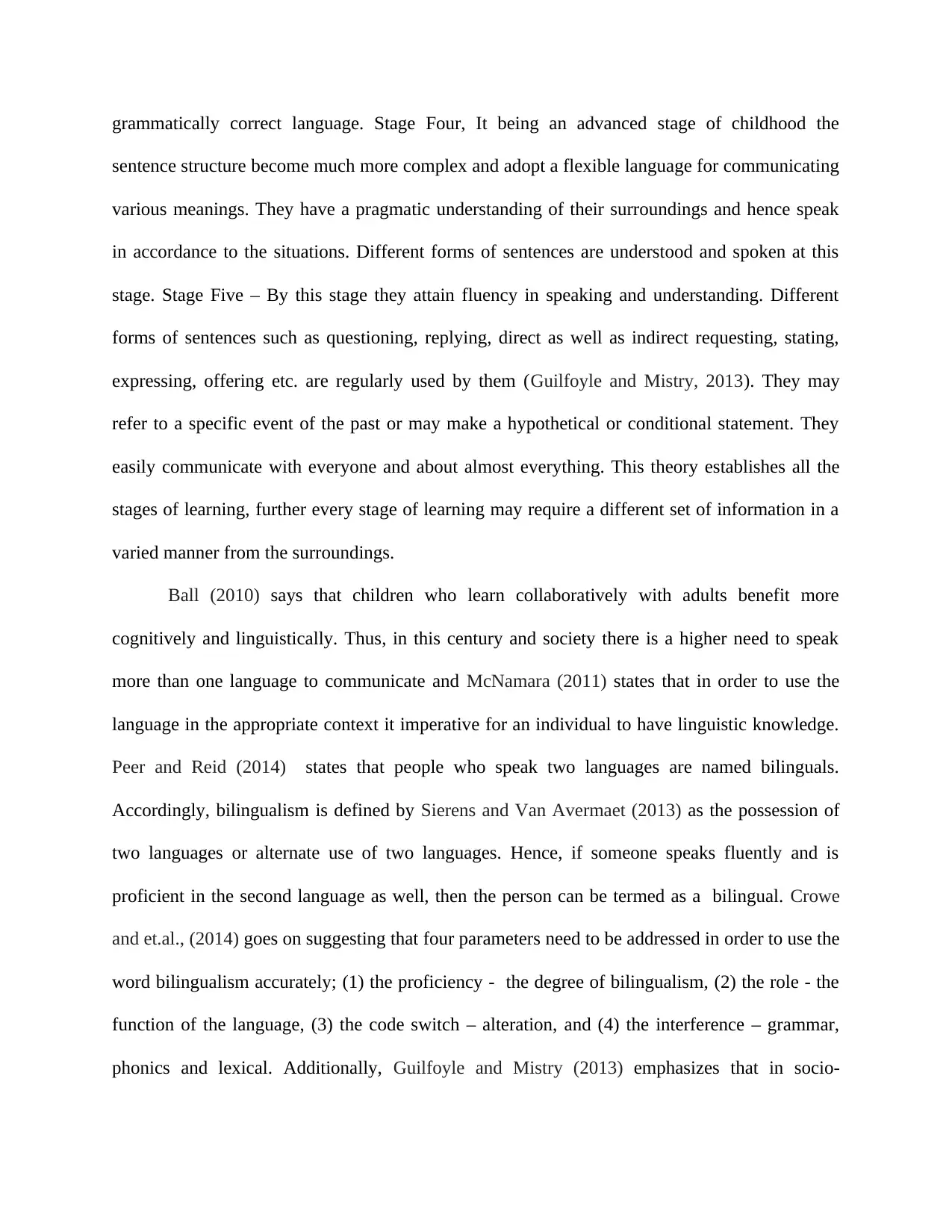
grammatically correct language. Stage Four, It being an advanced stage of childhood the
sentence structure become much more complex and adopt a flexible language for communicating
various meanings. They have a pragmatic understanding of their surroundings and hence speak
in accordance to the situations. Different forms of sentences are understood and spoken at this
stage. Stage Five – By this stage they attain fluency in speaking and understanding. Different
forms of sentences such as questioning, replying, direct as well as indirect requesting, stating,
expressing, offering etc. are regularly used by them (Guilfoyle and Mistry, 2013). They may
refer to a specific event of the past or may make a hypothetical or conditional statement. They
easily communicate with everyone and about almost everything. This theory establishes all the
stages of learning, further every stage of learning may require a different set of information in a
varied manner from the surroundings.
Ball (2010) says that children who learn collaboratively with adults benefit more
cognitively and linguistically. Thus, in this century and society there is a higher need to speak
more than one language to communicate and McNamara (2011) states that in order to use the
language in the appropriate context it imperative for an individual to have linguistic knowledge.
Peer and Reid (2014) states that people who speak two languages are named bilinguals.
Accordingly, bilingualism is defined by Sierens and Van Avermaet (2013) as the possession of
two languages or alternate use of two languages. Hence, if someone speaks fluently and is
proficient in the second language as well, then the person can be termed as a bilingual. Crowe
and et.al., (2014) goes on suggesting that four parameters need to be addressed in order to use the
word bilingualism accurately; (1) the proficiency - the degree of bilingualism, (2) the role - the
function of the language, (3) the code switch – alteration, and (4) the interference – grammar,
phonics and lexical. Additionally, Guilfoyle and Mistry (2013) emphasizes that in socio-
sentence structure become much more complex and adopt a flexible language for communicating
various meanings. They have a pragmatic understanding of their surroundings and hence speak
in accordance to the situations. Different forms of sentences are understood and spoken at this
stage. Stage Five – By this stage they attain fluency in speaking and understanding. Different
forms of sentences such as questioning, replying, direct as well as indirect requesting, stating,
expressing, offering etc. are regularly used by them (Guilfoyle and Mistry, 2013). They may
refer to a specific event of the past or may make a hypothetical or conditional statement. They
easily communicate with everyone and about almost everything. This theory establishes all the
stages of learning, further every stage of learning may require a different set of information in a
varied manner from the surroundings.
Ball (2010) says that children who learn collaboratively with adults benefit more
cognitively and linguistically. Thus, in this century and society there is a higher need to speak
more than one language to communicate and McNamara (2011) states that in order to use the
language in the appropriate context it imperative for an individual to have linguistic knowledge.
Peer and Reid (2014) states that people who speak two languages are named bilinguals.
Accordingly, bilingualism is defined by Sierens and Van Avermaet (2013) as the possession of
two languages or alternate use of two languages. Hence, if someone speaks fluently and is
proficient in the second language as well, then the person can be termed as a bilingual. Crowe
and et.al., (2014) goes on suggesting that four parameters need to be addressed in order to use the
word bilingualism accurately; (1) the proficiency - the degree of bilingualism, (2) the role - the
function of the language, (3) the code switch – alteration, and (4) the interference – grammar,
phonics and lexical. Additionally, Guilfoyle and Mistry (2013) emphasizes that in socio-
⊘ This is a preview!⊘
Do you want full access?
Subscribe today to unlock all pages.

Trusted by 1+ million students worldwide
1 out of 56
Your All-in-One AI-Powered Toolkit for Academic Success.
+13062052269
info@desklib.com
Available 24*7 on WhatsApp / Email
![[object Object]](/_next/static/media/star-bottom.7253800d.svg)
Unlock your academic potential
Copyright © 2020–2025 A2Z Services. All Rights Reserved. Developed and managed by ZUCOL.

